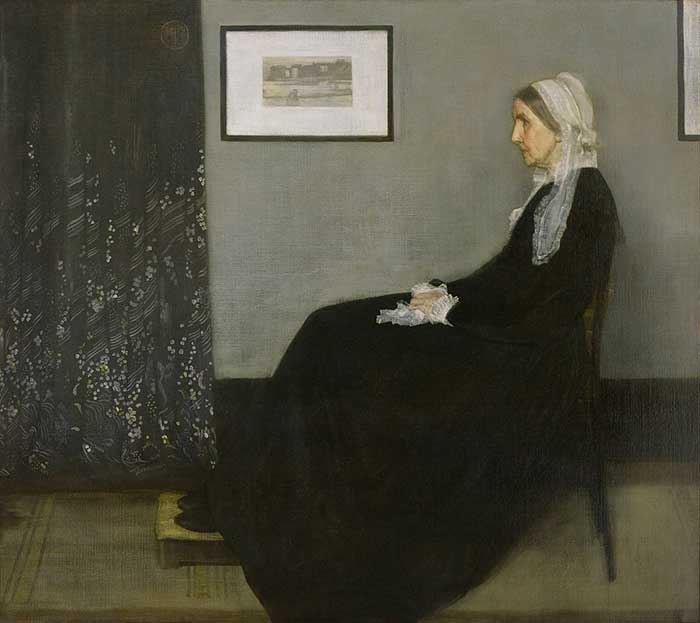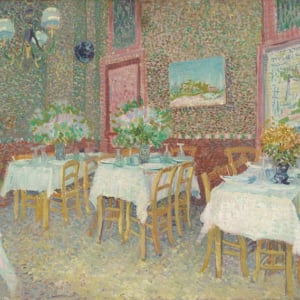This is a detailed guide on the idea of notan and how you can use it to improve your art. I’ll cover:
- What Does “Notan” Mean in Terms of Art?
- How to Use Notan in Painting
- What Makes a Strong Notan Design?
- How to Create Your Own Notan Studies
- 2 Value Notan
- 3 Value Notan
- 4 Value Notan
- Summary
- Thanks for Reading!
What Does “Notan” Mean in Terms of Art?
Notan is a Japanese term that literally means “light-dark harmony”. Artists use “notan studies” to explore different arrangements of light and dark elements in a painting without having the distraction of other elements like color, texture, and finer details.
In practice, this involves painting the darks with black and the lights with white (known as a 2 value notan). Sometimes, gray is also used as an intermediate value (3 or 4 value notans). A notan with more than 4 values is pretty much just a value study.
Below is an example of a 2 value notan study of James Whistler’s painting:


Notice how simple the notan is? The detail is simplified dramatically and all that is left is this the light and dark elements.
A mistake many artists make with notan studies is using too much detail, but that is missing the whole point of the notan study.
How to Use Notan in Painting
Every painting has some kind of balance between light and dark elements. Sometimes there is a strong clash between lights and darks (like in the Renaissance paintings), and sometimes it is more subtle (like in the Impressionist paintings).
However, the balance of light and dark elements in a painting is not always apparent at first glance, as there are many other elements competing for your attention, like color and brushwork.
A notan is used to filter out all these other elements so that the balance of light and dark elements is revealed. In a sense, a notan represents the most basic abstract design of a painting.
For example, take the following painting by Ilya Repin:

My simple 2 value notan eliminates all the “noise” in the painting and reveals what would appear to be a strong composition of lights and darks.

In some paintings, the notan design will be a dominant feature, with a strong arrangement of light and dark elements. In other paintings, the notan design will be less influential, and other elements will be the focus. This is apparent in many of the high-key paintings by the Impressionists which do not have strong underlying notan designs.

If I do a 2 value notan of this painting by Claude Monet, this is what I get. This is what I would call a weak notan design, as there is no balance between the light and dark elements or an interesting design.

This brings me to the point that whilst you can build a painting around a strong notan design, it is not essential to do so by any means. You could create a beautiful painting without any regard for the notan design, but you would just need to rely more on the other visual elements like color saturation, brushwork, and composition.
What Makes a Strong Notan Design?
Here are some key features of paintings which I consider to have strong notan designs:
- Strong value groups (lights grouped together and darks grouped together). This is the opposite of having values scattered all over the place. The painting by Sir Arthur Streeton below is a perfect example of value groups.
- Lights balanced against darks.
- An organic design.
- An interesting pattern created by the lights and darks.

How to Create Your Own Notan Studies
The purpose of a notan study in art is not to show off your dexterity with a brush. It is merely a composition tool to help you design your paintings. So it does not really matter how you do your notan studies.
Here are some of the different ways you can do a notan study:
- On your computer by simplifying the values and posterizing the image (you can do this in most editing programs).
- With white and black paint (the medium does not matter – oil, acrylic, or watercolor would be fine).
- With pencils (however, I suggest you use a dark grade of pencil).
- With thick, black markers.
The notans in this post were created either by using the posterize technique on the computer or with paint on canvas boards.
2 Value Notan
When creating a 2 value notan study, I use white for any areas which are hit by some kind of direct light and black for any areas which are not hit by direct light. The usual exceptions to this are objects which have white or black local colors (like a white dress or black suit). But even then, a white dress in shadow can appear darker than a black suit under direct light.
The other method I use is just to split the painting into two value groups: values that are above the halfway point in the painting and values which are below.
I also note that the use of white and black are merely symbolic. It does not mean the lightest light and darkest dark are actually white and black. White is just symbolic of light, and black is symbolic of dark.
A 2 value notan study is perfect for subjects that have a simple value structure and large shapes, like the painting below by Claude Monet:


You can always tell if a painting has a strong value composition if you can identify the subject through a 2 value notan. Take, for example, the intricate portrait below by Giovanni Boldini.
With just a 2 value notan you should be able to make out what the subject is. It provides a significant amount of information about the subject with only white and black. This is because Giovanni Boldini skillfully grouped the lights and darks so that there is this strong foundation built on value. This may not be apparent at first glance.


3 Value Notan
Most of the time a 2 value notan will be sufficient, but sometimes a painting will have a distinct mid-tone element that is overlooked when just using white and black. A 3 value notan is useful for paintings with a more sophisticated value structure. It provides more information about the subject, but the fundamental notan design tends to be less obvious.
The painting below by John Singer Sargent, whilst it is not the best example of a notan design, has a distinct light, mid-tone, and dark element. In this case, a third value is useful to capture those mid-tones.


4 Value Notan
For subjects that have 4 or more distinct value groups, you could use a 4 value notan. For this, you would use white, light gray, dark gray, and black.
As mentioned at the start of this post, if you use any more than 4 values then you are essentially doing a value study, not a notan study. Whilst a notan study and a value study are similar, a notan study is more focused on the abstract shapes and overall design created by the balance between light and dark. A value study is more realistic and captures the full range of values.
For the painting below by Ilya Repin, I provide 2, 3 and 4 value notans to demonstrate the differences between them. The 4 value notan seems to be useful in this case to capture some of the subtleties of the painting.

The 2 value notan provides the least information and ignores the mid-tones of the painting.

The 3 value notan captures the mid-tones, but I think we could do better with the addition of another value.

The 4 value notan accounts for light and dark mid-tone elements, which appears to be suitable for this painting.

Summary
- Notan refers to the balance between light and dark elements.
- You can use notan studies to explore the different arrangements or patterns of light and dark elements.
- Depending on how diverse the values are in your subject, you could use either a 2, 3, or 4 value notan study. Most of the time, a 2 value notan is all that is needed.
Thanks for Reading!
I appreciate you taking the time to read this post and I hope you found it helpful. Feel free to share it with friends. If you ever want to learn more, check out my Painting Academy course.
Happy painting!
Dan Scott

Draw Paint Academy







Very informative. Didn’t know about Notan! Thanks for once again a
valuable lesson.
No problem thanks Hetta, Dan
Very informative. Thank you!
very informative and value.thanks for your post.first time i am reading such things
My pleasure!
I will use this in my new painting, very informative.
Glad to hear Mari
What editing program do you use to establish a notan part of a painting? I am very interested in knowing more about that.
Thanks
Hi Jeannie. I use Photoshop (which is a paid subscription). But you should be able to do it with other free programs. I will look into it and might do another tutorial.
There’s a good phone app called See Value that does the job.
Thank a lot ,it great tool
Varda
Great information! I’m excited to give it a go. Thanks!
No problem thanks Annette! Dan
Very interesting and very helpful! Thank you.
Thanks Lazar!
I always enjoy your posts. I learn new thi gs with each one. I can’t wait to work on this. Thank you for showing me new ways to look at art and my own work. Always intriguing.
It is my pleasure Linda 🙂 Dan
Thank you Dan, I found this post most enlightening and always look forward to it.
Glad to hear Jennie! Dan
Never heard about notan before! Very useful to understand tones, a subject I’m struggling with. I’ll try it. Thanks dan
Thanks Ana glad you enjoyed it
Hello Dan,
Just want to say thank you for sharing your knowledge, I have never learned this much in all the 3 years I have spent in a painting class. I haven’t painted in a long while and now I am eager to get started!
Thank you again,
Carole
Hi Carole. Thanks so much for the very kind words. Really glad to read that. If you need anything, feel free to let me know. Dan
Now that’s a good read!
Great thanks Alvin
How interesting and so very helpful. I will look at painting ideas in a new way now. You are opening a new world to me! Thank you!
Thanks Elizabeth! Dan
Thank you. Those was very interesting makes me think about tones in a different way.
No problem Dorothy. Glad to hear the post helped! Thanks, Dan
MY TUTOR IN THE STUDIO THAT I PAINT TALK WITH ME ABOUT NOTAN AND I SEARCH IN THE INTERNET TO SEE WHAT U SAY ABOUT IT, IT WAS SO HELPFULL. THANK U A LOT
No problem at all! Happy to have helped. Thanks, Dan
CAN YOU BUY A NOTAN APP? Is it on Photoshop?
Hi Frances
Yes, I use Photoshop. But I believe there are also apps you can download on your phone.
Dan
This piece of writing offers clear idea for the new
people of blogging, that in fact how to do blogging and site-building.
Hello Dan, as a new and self-taught artist, I am eager to learn and capture and understanding of the various tools and aspects of painting. Notans are still a struggle. Your writing and examples were very helpful. I will continue with my practice.
Thank you!
Taylor
In this lesson, I understood the importance and application of tones. Thanks.
Thank you for sharing your understanding and insights.A great blog🌷
Varda
Hello! When designing a composition and using notan to determine if it’s balance, how do I know if it really is balanced and how do I fix it when it is off balance?
Best notan explanation, with examples, that I’ve ever seen. Thanks!
You used to have a notan posted of the Lady of Shalott. It was one of my more favorite images. Why did you take it down?
Nicely done! I have done some notan in prep for plein air painting. I can see you are using Photoshop filters to establish the notan composition. ( desaturate/posterize?)
The problem I see with this is it doesn’t account for relative value, the value changes of adjacent areas. This is how my eye reads a painting.
For example, you could have done the Ilya Repin in two values if you assigned white to some of his lips, his hand, ear, and the shadow side of his face. Then the figure would be recognizable. Certainly in a 3 value notan, I would break it up very different than Photoshop does with all those areas at least a middle tone.
Photoshop did some odd things in the break up the background which we tend to see as more unified, no doubt because it is the same hue. I guess this underscores a weakness in (Photoshop) notan- it doesn’t take color into account.
Anyway, just some observations. Thanks for posting this.
Thank you so much for this post … your posts are always helpful and insightful and so well explained THANK YOU AGAIN
Over complcated and unecessary. People need to learn to make art built on their unique response to the world, stuff like this implies there’s a formula to doing it. There isn’t!
Thank you for your generous writings so useful for people like me who are trying to make their way through the intricate forest of knowledge about art.
There is VAST information on the internet about what a notan is, why make a notan and how to make one. There is NO information anywhere on how to IMPROVE a notan. I can have strong value groups, a balance of lights and darks, and an organic design and STILL have a poor notan. I don’t know what “an interesting pattern of lights and darks” means.